The Calico Aster, also known as Side-Flowering Aster, Starved Aster, or White Woodland Aster, is a hardy herbaceous perennial from the Asteraceae family. Native to regions spanning from Canada to Mexico, this wildflower thrives in partial shade and is commonly found along forest edges, open meadows, and fields.
Gardeners value the Calico Aster for its delicate, star-shaped flowers that create a charming display late in the growing season. Requiring minimal maintenance, this low-maintenance perennial is well-suited for naturalized landscapes, pollinator gardens, and woodland borders. Its ability to adapt to varying conditions makes it a versatile addition to many garden settings.
| Common name | Calico Aster, Side-Flowering Aster, Starved Aster, White Woodland Aster |
| Botanical name | Aster lateriflorus |
| Family | Asteraceae |
| Species | lateriflorus |
| Origin | Canada to Mexico |
| Life cycle | Perennial |
| Plant type | Herbaceous Perennial |
| Hardiness zone | 4, 5, 6, 7, 8 |
| Sunlight | Partial Shade |
| Maintenance | Low |
| Soil condition | Clay |
| Soil ph | Acid |
| Drainage | Well-Drained |
| Spacing | 3 ft. – 6 ft. |
| Flowering period | Fall |
| Height | 1 ft. – 4 ft. |
| Flower color | Gold, Yellow |
| Leaf color | Green |
| Stem color | Brown, Copper |
| Fruit type | Achene |
| Flower benefit | Showy |
| Garden style | Butterfly Garden |
| Uses | Meadow |
I. Appearance and Characteristics
Symphyotrichum lateriflorum (formerly Aster lateriflorus) is a species of flowering plant in the aster family (Asteraceae). Commonly known as calico aster, starved aster, and white woodland aster, it is native to eastern and central North America. It is a perennial and herbaceous plant that may reach heights up to 120 centimeters (4 feet) and widths up to 30 centimeters (1 foot).
Symphyotrichum lateriflorum is a clump-forming perennial that grows 20–120 centimeters (3⁄4–4 feet) tall and up to 30 cm (1 ft) wide. Herbaceous and with alternate leaves, it can have a different appearance throughout its lifespan or a season. For example, a mature or returning plant, or one late in the season, may have one or more stiff stems that reach close to maximum height, several arching branches, and multiple clusters of flowers (inflorescences). An early or first-year plant may have one short and somewhat floppy stem, several large leaves, and end abruptly with one flower head in the center.
- Roots
The roots of Symphyotrichum lateriflorum have short and woody branched caudices, and can have short rhizomes that may produce offsets. The images of caudices are from dried specimens that are stored in the New York Botanical Garden (NYBG) Steere Herbarium.
- Stems
Symphyotrichum lateriflorum has from one to five stems growing from the root base. These stems can be a reddish or purplish color, often with a woody appearance, or a shade of green. Characteristics can depend on the prevalence of sun, with the green stems occurring more likely in the shade.
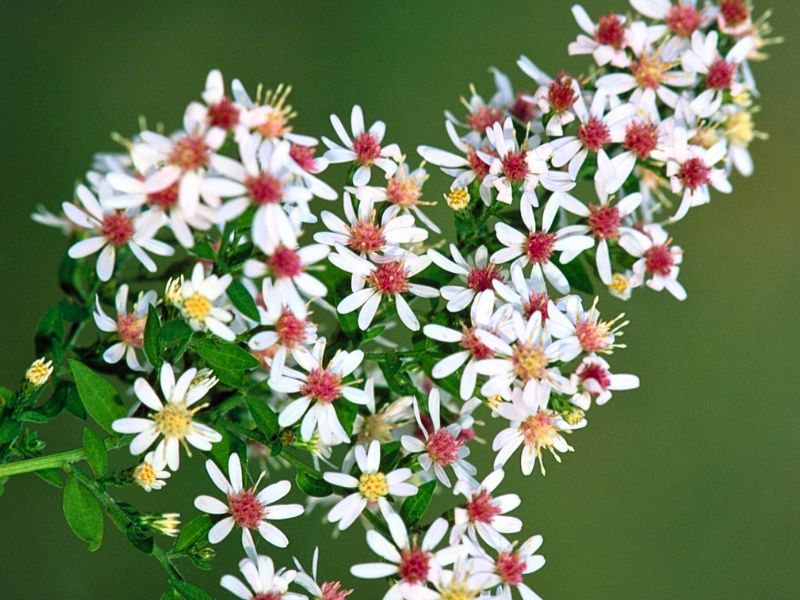
Slender and wiry inflorescence-filled branches grow from the stems at almost a right angle or in long arches. Shorter branches may ascend rather than arch. Stems and branches can be covered with fine soft hair, but sometimes the amount of hair is reduced farther from the base, mid-stem, or as it goes up the stem. The hair usually grows in vertical lines, particularly on the inflorescence branches.
- Leaves
Symphyotrichum lateriflorum has alternate and simple leaves. Characteristics vary among leaves on the same plant and on plants in different environments and areas of the range. Leaves occur at the base, on stems, and on inflorescence branches. The farther away from the base the leaves are, the smaller they become, sometimes markedly so. By the time flowers appear, the leaves at the base and stem have often withered or fallen. Leaves have fine, reticulate veins and little to no hair except for the key characteristic of hair on the back, or abaxial, midrib. This abaxial midrib hair sometimes can all but disappear as the plant ages within a season.
Basal, or bottom, leaves vary in shape from oblanceolate, lance-ovate, ovate, spatulate, to nearly circular. They are thin and the least lance-shaped, with a short or no leafstalk. Basal leaf sizes vary, measuring about 3–35 millimeters (0.1–1.4 inches) in length by 7–25 mm (0.3–1.0 in) in width. The surfaces feel slightly rough to the touch, and the edges are wavy or saw-toothed. Leaves may or may not come to a point at the end depending upon their shape.
Lower and middle stem leaves have no leafstalk, meaning they are sessile, or they have a very short leafstalk with wings. The shapes of the stem leaves vary from ovate or elliptic to elliptic-oblanceolate or lanceolate, rarely linear-lanceolate. Sizes become much smaller the farther they grow from the base. In length, they are 5–10 cm (2–4 in) with widths 1–2 cm (0.4–0.8 in).
Distal leaves, higher on the stem and on the branches with the flower heads, are also sessile. Their margins are sometimes entire, smooth on the edges with no teeth or lobes. Sizes range from 1 cm (0.4 in) to 15 cm (6 in) in length and up to 3 cm (1.2 in) in width. The more distal, the smaller they are, and this change can occur abruptly.
- Flowers
Symphyotrichum lateriflorum is a late-summer and fall blooming perennial, the flower heads opening as early as July in some locations and as late as October in others. The flower heads grow in arrays called panicles and are racemose. They generally stay on the upper sides of their stalks, which are called peduncles. The flower heads at the ends of the peduncles mature approximately one week before those on the rest of the plant.
Each flower head is about 13 mm (0.5 in) diameter when in bloom, and is either sessile or with a usually hairy (specifically, pilose) peduncle which is less than 10 mm (0.4 in) in length. At the base of a flower head are from one to seven bracts which look like (and technically are) small leaves that grade into the phyllaries.
- Fruit
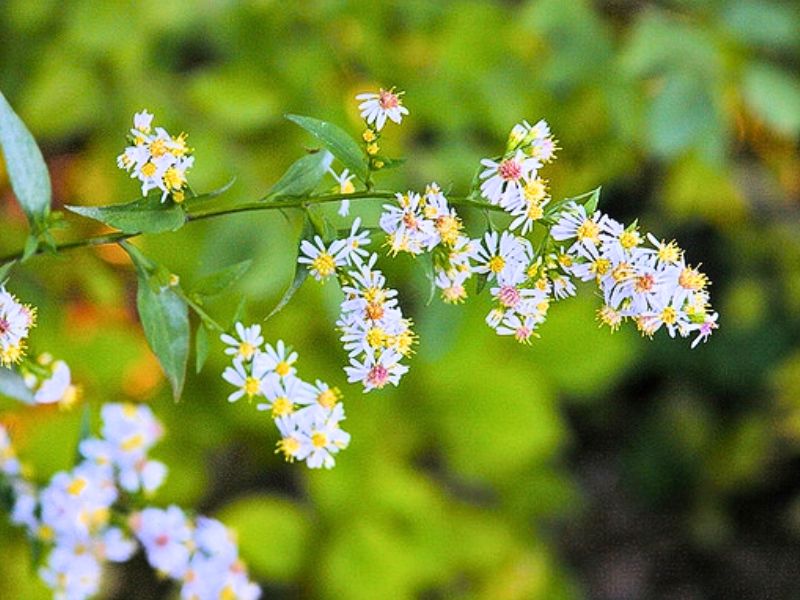
The fruits (seeds) of Symphyotrichum lateriflorum are not true achenes but are cypselae, resembling an achene and surrounded by a calyx sheath. This is true for all members of the Asteraceae family. After pollination, they mature in and become gray or tan with an oblong-obovoid shape, 1.3–2.2 mm (0.051–0.087 in) in length with , and with a few stiff, slender bristles on their surfaces (strigillose). They also have tufts of hair (pappi) on the top which are white to pinkish and 3–4 mm (0.12–0.16 in) in length.
- Chromosomes
Symphyotrichum lateriflorum has a base number of eight chromosomes Diploid, tetraploid, hexaploid, and octaploid plants with respective chromosome counts of 16, 32, 48, and 64 have been reported.
II. How to Grow and Care
Sunlight
Calico aster will grow in most light conditions but prefers to be in partial sun. It will grow in shady areas and does very well in partial shade conditions. Sometimes if grown in full sun, the calico aster will reseed more aggressively than in shady spots.
Temperature and Humidity
Like other native asters, the calico aster is very cold hardy. In areas with hot summers, it does best in shady or semi-shady locations.
It needs good air circulation to avoid a tendency to get powdery mildew on its leaves in humid conditions, so if the plants start to get too crowded, thin them out.
Avoid growing in wet or swampy areas.
Watering
The calico aster is fairly drought tolerant, but in prolonged periods of dry or hot weather, it may need some extra water. Water regularly in spring when new young plants appear.
Soil
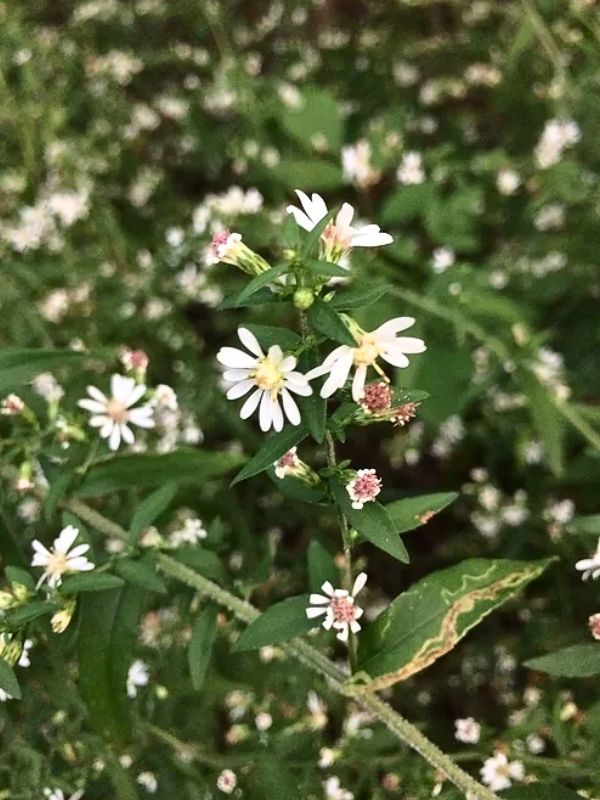
The calico aster is fairly tolerant of different soil types and will grow in clay soils or thin soils, but it prefers a well-drained, moderately fertile soil. Its ability to survive in hard or dry soils in shady conditions make it quite tenacious with a tendency to be invasive.
Fertilizing
The calico aster doesn’t need supplemental fertilizer of any kind.
Pruning
The calico aster doesn’t need pruning, though some gardeners will cut it back in fall when it can be cut back all the way to the ground.
It’s not a bad idea to deadhead or snip off the flowers before they go to seed to help prevent it from spreading too invasively in your garden.
Propagation
This native aster tends to self-propagate, meaning it self-seeds. The tiny seeds are spread by wind, foot traffic, and wildlife, like birds and rodents.
Like many native plants, it can be resistant to cultivation, but this one may be easily dug up from its wild spots and transplanted.
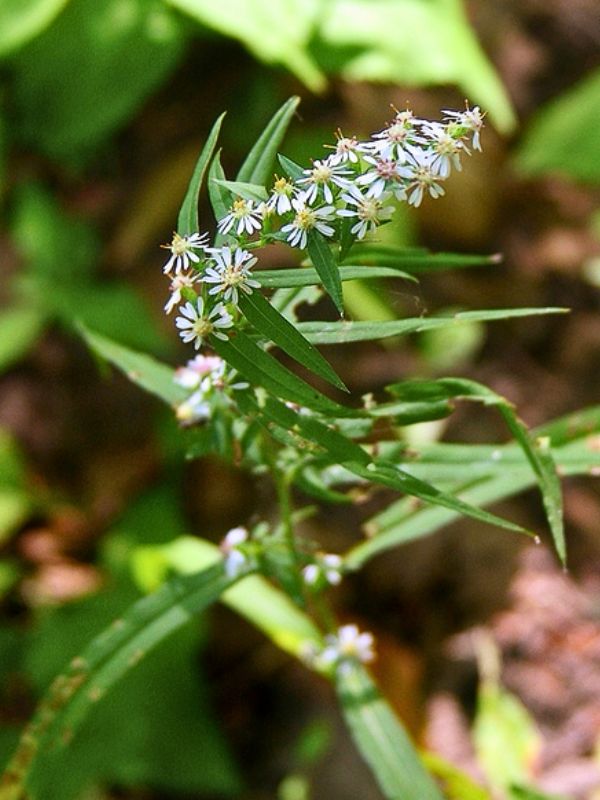
Transplant your calico asters in spring or fall by digging up or dividing the clumps. Choose a semi-shaded spot for the separated plants, especially if your summers tend to get hot. Water well after planting.
Pests and Diseases
Calico aster is an extremely hardy plant. It’s not generally bothered by pests and is visited by many different insect pollinators.
It is somewhat susceptible to a few diseases: verticillium wilt and powdery mildew.
Verticillium wilt is caused by six different species of fungi found in soil. Plants affected by this disease will tend to get yellow leaves, which will then turn brown before the plant dies. There is no known treatment for it, but affected plants should be removed from your garden and thrown away (don’t put it in your garden compost).
Powdery mildew is common for calico asters and occurs when plants don’t have enough air circulation, whether because they have grown too large, are crowded by other plants, or are growing too close to a wall, fence, or other structure.
Cut away any affected leaves. If the powdery mildew affects the entire plant, dig it out and dispose of it separate from your garden compost.
III. Uses and Benefits
- Ornamental uses
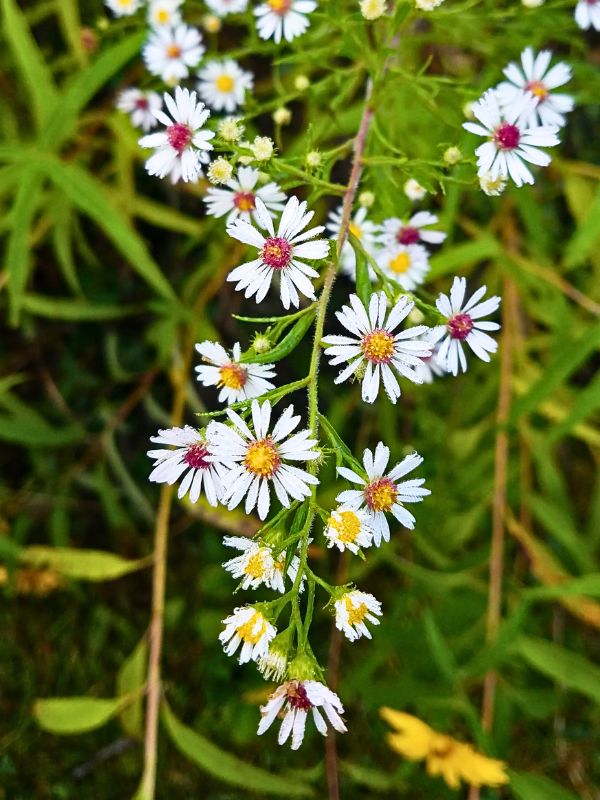
In 1928, ethnobotanist Huron Herbert Smith documented the Meskwaki use of this plant as a psychological aid using the “blossoms as a smudge ‘to cure a crazy person who has lost his mind’”, and as an herbal steam using the entire plant “as a smoke or steam in sweatbath”. The Meskwaki word is , and the Potawatomi . Both words mean “smoke a person”. In her 1979 book Use of Plants for the Past 500 Years, Charlotte documented that the Mohawk people use an infusion of this plant with Symphyotrichum novae-angliae to treat fever.
- Culinary uses
Calico aster is a common bushy perennial known for its masses of mini daisy-like flowers. Its low-growing and dense habit make it very popular as a border plant, groundcover, or accent to paths and walkways. Calico aster can also be encouraged to grow as a hedge. Perfect in cottage and wildlife gardens. Excellent companion plants include verbenas, sedums, and black-eyed Susans.
Find Where to Buy the Best Calico Aster (Aster lateriflorus)





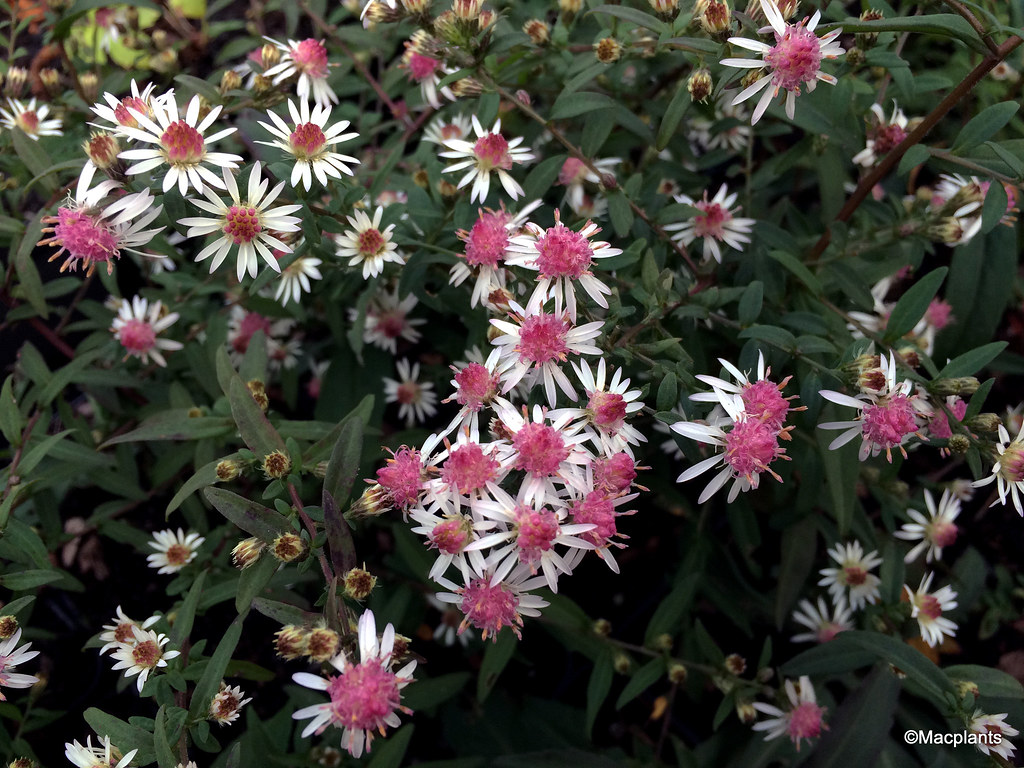










Leave a Reply